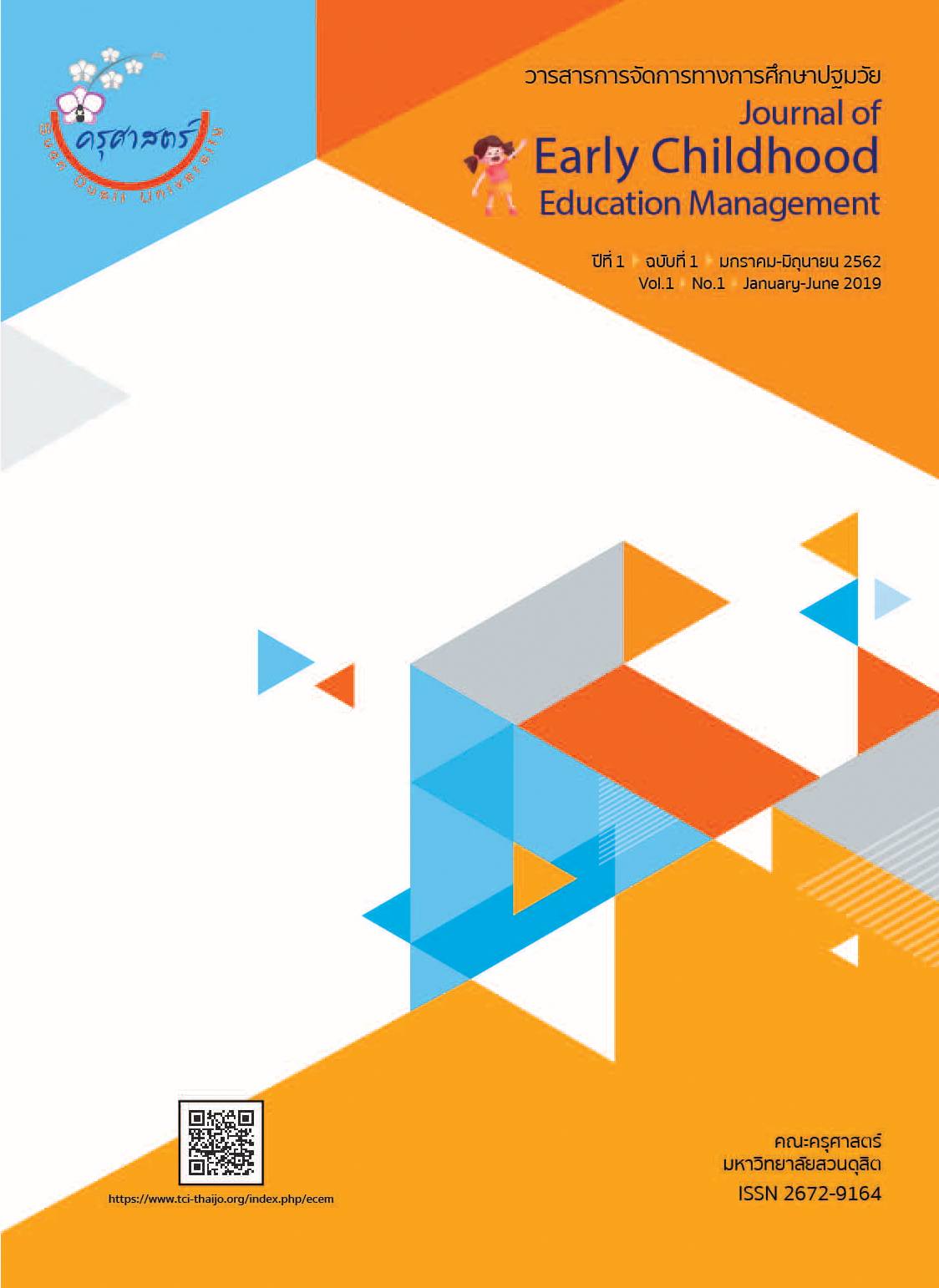The Meaning of “A Half” from the Perceptions of 3-5-Year-Old Children
DOI:
https://doi.org/10.14456/jecem.2019.2คำสำคัญ:
fraction concept, numeracy concept development, children’s numeracy perceptionบทคัดย่อ
In everyday life, young children experience “half” such as sharing a half of candies with a friend. As a half is a fraction value, which considered as one of the difficult concepts for primary school students, we were then interested in how children interpret “half.” Totrace 3-5-year-old children’s perception of “half,” we developed the activities “Sharing a half” and “Taking a half.” There were 6 children participated in the activities. The method of summative content analysis was applied for analyzing the data collected from children’s responses while they participated in the activities. The results showed that some of the children perceived the meaning of a half as one part of two equal parts. We also found that the understanding of cardinality did not affect children’s concept of a half. Our findings evidenced that children who either understood cardinality or do not understand cardinality percept “a half” correctly. Some children (mostly 3 years old) had no concept of “a half.”
เอกสารอ้างอิง
Brannon, E.& Van de Walle, G. (2001). The development of ordinal numerical competence in young children. CognitivevPsychology, 43(1), 53-81.
Empson, S. & Levi, L. (2011). Extending children’s mathematics: Fractions and decimals: Innovations in cognitively guided instruction. Portsmouth, NH: Heinemann.
Fleer, M &Raban, B.(2007). Early childhood literacy and numeracy: building good practice. http://docs.education.gov.au/system/files/doc/other/ed13-0077_ec_literacy_and_numeracy_building_good_practice_resources_booklet_acc.pdf
Gelman, R. & Gallistel, C. (1978). The child’s understanding of number. Cambridge, MA: Harvard University.
Gelman, R. (2002). Cognitive development. In H. Pashler& D. Medin. (Eds.), Steven’s handbook of Experimental psychology, Vol. 2: Memory and cognitive processes (533–559). New York, NY: John Wiley & Sons.
Gersten, R. & Chard, D. (1999). Number sense: Rethinking arithmetic instruction for students with mathematical disabilities. The Journal of Special Education, 33(1), 18-28.
Kamii, C. & Clark, F. B. (1995). Equivalent fractions: Their difficulty and educational implications. Journal of Mathematical Behavior, 14(4), 365-378.
Malofeeva, E., Day, J., Saco, X., Young, L.&Ciancio, D. (2004). Construction and evaluation of a number sense test with head Start children. Journal of Educational Psychology, 96(4), 648.
Malofeeva, E., Day, J., Saco, X., Young, L. & Ciancio, D. (2004). Construction and evaluation of a number sense test with Mathematical Thinking and Learning: An International Journal, 17(2-3), 197-218.
Moss, J. & Case, R. (1999). Developing children’s understanding of the rational numbers: A new model and an experimental curriculum. Journal for Research in Mathematics Education, 30(2), 122-147.
Muldoon, K., Lewis, C. &Towse, J. (2005). Because it’s there! Why some children count, rather than infer numerical relationships. Cognitive Development, 20(3), 472-491.
Purpura, D. & Napoli, A. (2015). Early numeracy and literacy: Untangling the relationship between specific components. Mathematical Thinking and Learning: An International Journal, 17 (2-3), 197-218.
Reid, Kate. (2016). Counting on it: Early numeracy development and the preschool child. http://research.acer.edu.au/learning processes/19.
Song, M.J. & Ginsburg, H. P. (1987). The development of informal and formal mathematical thinking in Korean and U.S.children. Child Development, 58, 1286-1296.
Sophian, C., Harley, H. & Manos Martin, C. S. (1995). Relational and representational aspects of early number development. Cognition and Instruction, 13(2), 253-268.
Wynn, K. (1996). Infants’ individuation and enumeration of actions. Psychological Science, 7, 164-169.
Xu, F. &Spelke, E. S. (2000). Large number discrimination in 6-month-old infants. Cognition, 74,1-11.
Xu, F.(2003). Numerosity discrimination in infants: Evidence for two systems of representations. Cognition, 89, 15-25.
Xu, F., Spelke, E. S.& Goddard, S. (2005). Number sense in human infants. Developmental Science, 8, 88-101.
ดาวน์โหลด
เผยแพร่แล้ว
รูปแบบการอ้างอิง
ฉบับ
ประเภทบทความ
สัญญาอนุญาต
ลิขสิทธิ์ต้นฉบับที่ได้รับการตีพิมพ์ในวารสารการจัดการทางการศึกษาปฐมวัย ถือเป็นกรรมสิทธิ์ของคณะครุศาสตร์ มหาวิทยาลัยสวนดุสิต ห้ามผู้ใดนำข้อความทั้งหมดหรือบางส่วนไปพิมพ์ซ้ำ เว้นแต่จะได้รับอนุญาตอย่างเป็นลายลักษณ์อักษรจากคณะครุศาสตร์ มหาวิทยาลัยสวนดุสิต นอกจากนี้ เนื้อหาที่ปรากฎในบทความเป็นความรับผิดชอบของผู้เขียน ทั้งนี้ไม่รวมความผิดพลาดอันเกิดจากเทคนิคการพิมพ์




